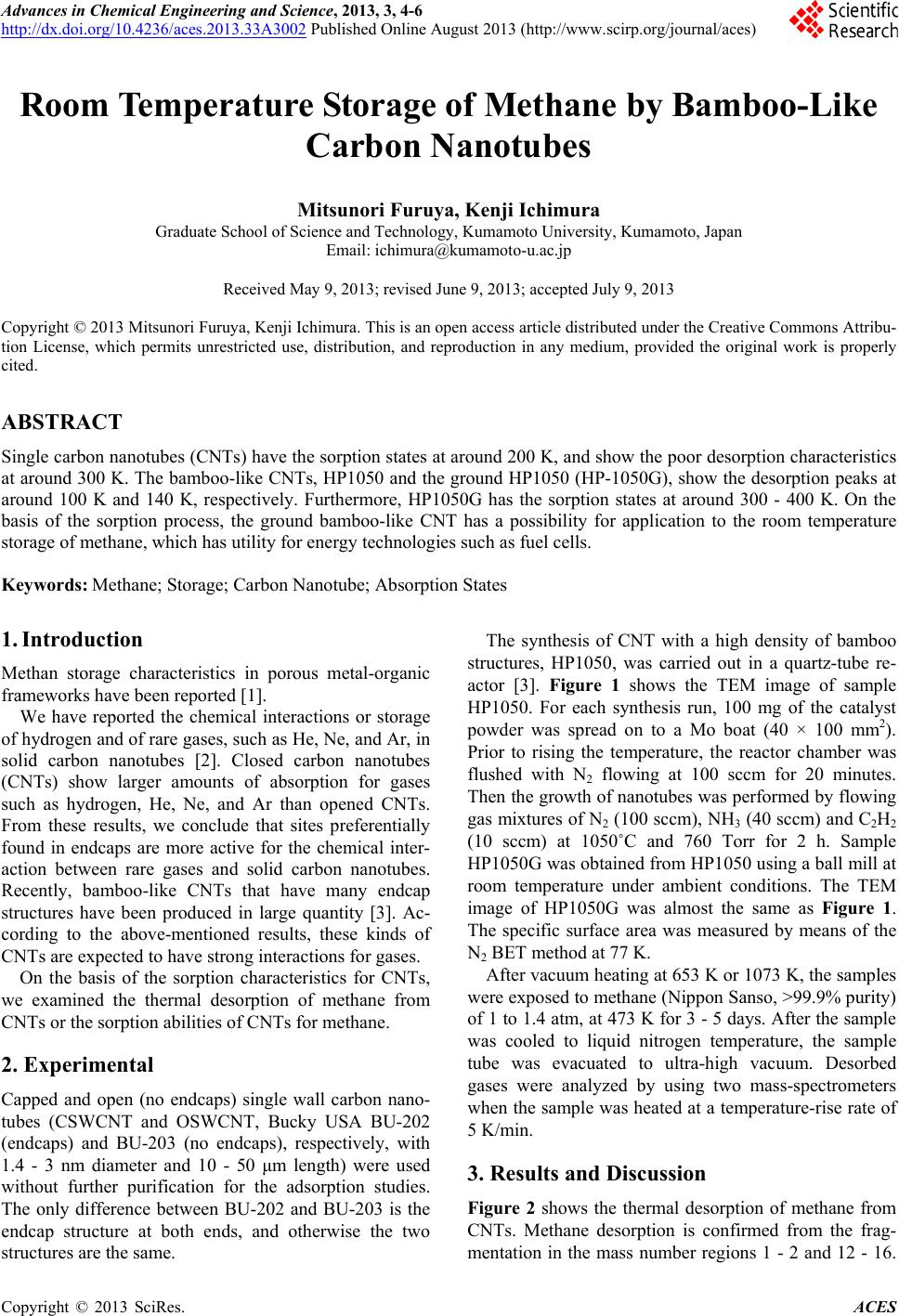
Advances in Chemical Engineering and Science, 2013, 3, 4-6
http://dx.doi.org/10.4236/aces.2013.33A3002 Published Online August 2013 (http://www.scirp.org/journal/aces)
Room Temperature Storage of Methane by Bamboo-Like
Carbon Nanotubes
Mitsunori Furuya, Kenji Ichimura
Graduate School of Science and Technology, Kumamoto University, Kumamoto, Japan
Email: ichimura@kumamoto-u.ac.jp
Received May 9, 2013; revised June 9, 2013; accepted July 9, 2013
Copyright © 2013 Mitsunori Furuya, Kenji Ichimura. This is an open access article distributed under the Creative Commons Attribu-
tion License, which permits unrestricted use, distribution, and reproduction in any medium, provided the original work is properly
cited.
ABSTRACT
Single carbon nanotubes (CNTs) have the sorption states at around 200 K, and show the poor desorption characteristics
at around 300 K. The bamboo-like CNTs, HP1050 and the ground HP1050 (HP-1050G), show the desorption peaks at
around 100 K and 140 K, respectively. Furthermore, HP1050G has the sorption states at around 300 - 400 K. On the
basis of the sorption process, the ground bamboo-like CNT has a possibility for application to the room temperature
storage of methane, which has utility for energy technologies such as fuel cells.
Keywords: Methane; Storage; Carbon Nanotube; Absorption States
1. Introduction
Methan storage characteristics in porous metal-organic
frameworks have been reported [1].
We have reported the chemical interactions or storage
of hydrogen and of rare gases, such as He, Ne, and Ar, in
solid carbon nanotubes [2]. Closed carbon nanotubes
(CNTs) show larger amounts of absorption for gases
such as hydrogen, He, Ne, and Ar than opened CNTs.
From these results, we conclude that sites preferentially
found in endcaps are more active for the chemical inter-
action between rare gases and solid carbon nanotubes.
Recently, bamboo-like CNTs that have many endcap
structures have been produced in large quantity [3]. Ac-
cording to the above-mentioned results, these kinds of
CNTs are expected to have strong interactions for gases.
On the basis of the sorption characteristics for CNTs,
we examined the thermal desorption of methane from
CNTs or the sorption abilities of CNTs for methane.
2. Experimental
Capped and open (no endcaps) single wall carbon nano-
tubes (CSWCNT and OSWCNT, Bucky USA BU-202
(endcaps) and BU-203 (no endcaps), respectively, with
1.4 - 3 nm diameter and 10 - 50 μm length) were used
without further purification for the adsorption studies.
The only difference between BU-202 and BU-203 is the
endcap structure at both ends, and otherwise the two
structures are the same.
The synthesis of CNT with a high density of bamboo
structures, HP1050, was carried out in a quartz-tube re-
actor [3]. Figure 1 shows the TEM image of sample
HP1050. For each synthesis run, 100 mg of the catalyst
powder was spread on to a Mo boat (40 × 100 mm2).
Prior to rising the temperature, the reactor chamber was
flushed with N2 flowing at 100 sccm for 20 minutes.
Then the growth of nanotubes was performed by flowing
gas mixtures of N2 (100 sccm), NH3 (40 sccm) and C2H2
(10 sccm) at 1050˚C and 760 Torr for 2 h. Sample
HP1050G was obtained from HP1050 using a ball mill at
room temperature under ambient conditions. The TEM
image of HP1050G was almost the same as Figure 1.
The specific surface area was measured by means of the
N2 BET method at 77 K.
After vacuum heating at 653 K or 1073 K, the samples
were exposed to methane (Nippon Sanso, >99.9% purity)
of 1 to 1.4 atm, at 473 K for 3 - 5 days. After the sample
was cooled to liquid nitrogen temperature, the sample
tube was evacuated to ultra-high vacuum. Desorbed
gases were analyzed by using two mass-spectrometers
when the sample was heated at a temperature-rise rate of
5 K/min.
3. Results and Discussion
Figure 2 shows the thermal desorption of methane from
CNTs. Methane desorption is confirmed from the frag-
mentation in the mass number regions 1 - 2 and 12 - 16.
C
opyright © 2013 SciRes. ACES